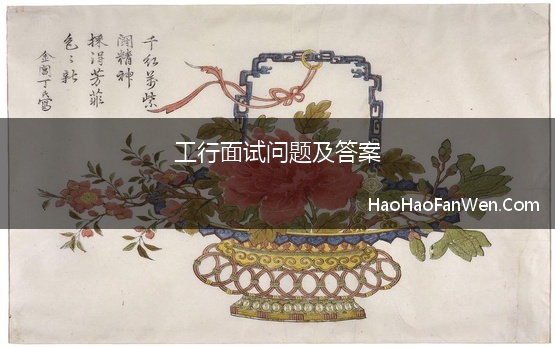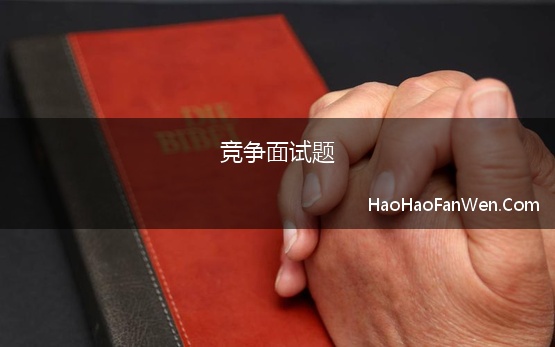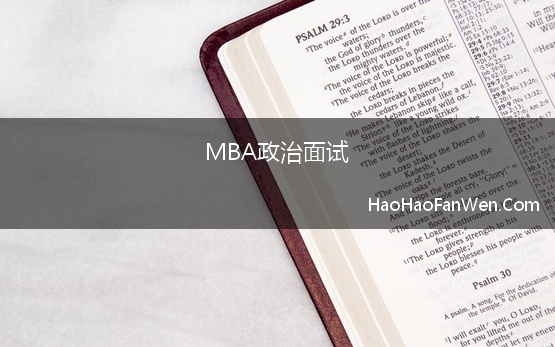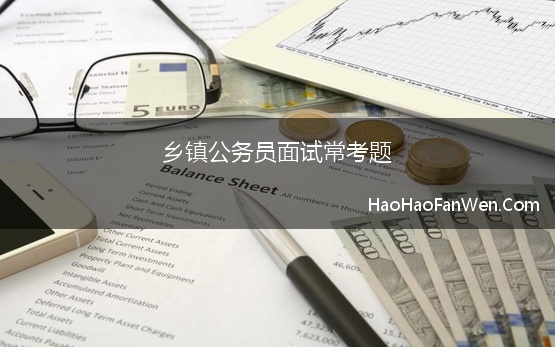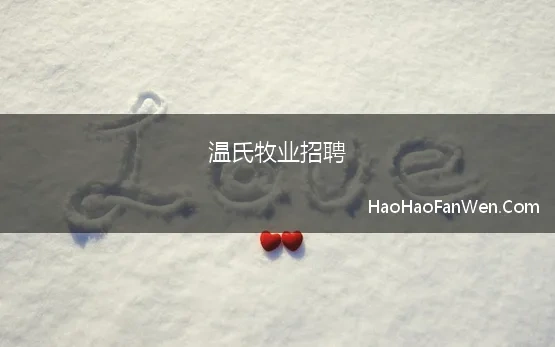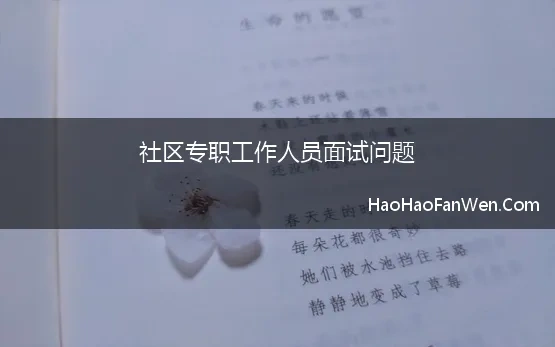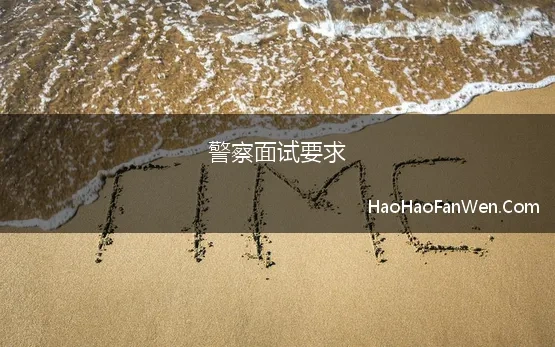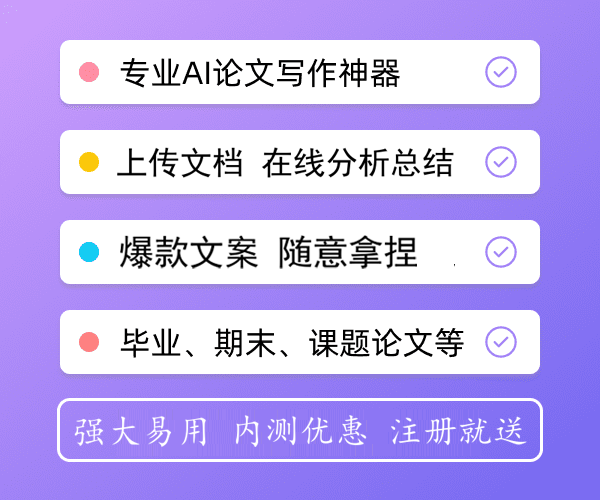大副面试问题及参考答案(仅供参考)
下面是好好范文网小编收集整理的大副面试问题及参考答案(仅供参考),仅供参考,欢迎大家阅读!

大副是甲板上仅于船长的“第二把手”。大副的好坏直接关系到船舶、货物和人身安全。经验表明,船东在面试大副时也是相当严格和认真的。主要集中在货物的配载、装卸货、货物的保管、货物单据、管理能力等方面。而对于特种船来说,对有关货物装卸货的有关规定等也要熟知。此外,有关ISM/SMS及其他公约、PSC检查以及船东内外审时的提问也是一个非常重要的部分。
1.Can you tell me about your educational background and working experience?
A reference answer:
I graduated from Jimei Navigation Collage in 1992. I studied there for three years. I have worked as a seaman on eight ships for nearly ten years. I have the experience of Chief Officer for two ships. I have worked both Chinese and foreign shipowners in the past ten years.
2. Can you tell me the responsibilities of the Chief Officer?
Under the leadership of the Master, the Chief Officer shall carry out the daily management of the deck department, and he is also responsible for cargo handling. The specific duties include:
(1)Watch-keeping from 0400~0800 hours and 1600~2000 hours.
(2)Safety of the ship and work place, safety equipment.
(3)Daily safety and sanitary inspection.
(4)Store and spare parts inventory management.
(5)Maintenance on deck.
(6)Stowage plan making.
(7)Supervision of the loading and unloading process.
(8)Cargo caring on board.
(9)Some other work and designated by the master of the vessel.
3.Can you talk about the previous vessels (last vessel) you worked on board?
It was an ocean-going ship, but it mainly loaded cargoes in Asia and discharged in Europe. It was an old ship about 14 years old. But the general condition of the ship was quite good because we did very good maintenance work on board
4.What types of cargoes have ever been carried on board your last vessel?
I have worked on bulk carriers and general cargo vessels and I have experienced a lot of cargo handling.
这是一个很重要的问题,因为大副的一个很重要职责便是货物管理。大副应该对不同货物的装卸、配载、保管、单据、保险等相关问题有所了解。
5.Where was your last vessel’s trading (plying, sailing) area?
It was an ocean-going ship, but it mainly loaded cargos in Asia and discharged in Europe. She has ever been to New Orleans, Long Beach, New York, Rotterdam, Hamburg and so on.
6.Did you have the experience of working with foreign crews? What were their nationalities?
The last two vessels I worked on had crew from several countries. The masters were Indian, the Chief Engineer were from Hong Kong and Philippine and other seamen from china, Indian, Burma and Vietnam.
7.Can you tell me how to make a stowage plan?
Based on the capacity of the hold, the stowage factors, types of cargo, loading and discharging ports rotation, port draft limitation, loading-line area. I shall calculate the volume of the cargo that is to be loaded into different holds. Then I shall calculate the draft of the vessel and trimming, shear force, bending moment to meet the requirements of the ship. At last, stowage plan in made based on these factors.
8.What does stowage factor of mean?
A stowage factor of any cargo is the figure that expresses the number of cubic units of measure needed to accommodate one unit of weight-how many cubic meters is needed to stow on metric ton of certain goods. Stowage factors should include allowance for dunnage, irregular size of certain goods, pallets and something else. Even the most carefully determined stowage factor is not absolute and it should be used only as guide while planning cargo disposition.
9.If there happens stevedore damage to cargo, equipment or ship’s structure in the loading or discharging ports, what should you do?
If damage happens, I must record it first and then report it in an appropriate written form to the master and other parties concerned. The report must be signed by the liable parties admitting they have (or have not) responsibility for the damage. The damage report shall be carefully worded and shall be supported with photos and other evidence, if any. The damage report should also include the following contents: ship’s name, voyage number, date, geographical location, name of the person who took the photos and his signature, location where the photo was taken, and what is intended to show.
10.What precautions do you have to take before cargo operation is carried out?
I shall check the pre-cargo operation check lists to make sure that no item is missing. The following procedures are to be adopted:
(1)The Chief Officer shall make a cargo operation plan, in which the following factors shall be considered: the cargo must be stowed in such way that the stability, trim, shearing forces and bending moments are within the limits as laid down by the stability manual; excessive weight on tank tops, tween decks and hatch covers must be avoided; and cargo must be stowed and secured in such way as to avoid damage which can result in possible loss of life or property.
(2)Pre-operation conference with all ship’s personnel to be involved in the cargo operation should be held to discuss such matters as cargo disposition, numbers of gangs and working hours, usual and special safety requirements, ballasting and de-ballasting information, special requirements regarding cargo operation, damage prevention and control, personnel organization, cargo watch etc. The Chief Officer must ensure that all relevant personnel have fully understood the intended cargo and all usual and special safety and operational requirements.
11.What will you do if cargo damage is found or suspected before loading or during loading?
I shall report to the master first and foremost. The master should decide whether to replace the damaged cargo. For the full-set machines and high-valued products I must ask for the replacement in the loading port if damages are found. If the damaged cargoes cannot be replaced, the Chief Mate shall make remarks on the Mate’s Receipt.
If disputers happen on the quantity and quality of the cargoes, I shall, at the discretion of the master, ask the cargo surveyor to do the survey. If necessary, under the endorsement of the ship owner, I shall write a Letter of Protest (based on the format provided by the company) to prove the innocence of the seamen on board.
During the voyage, if a very small amount of cargo is damaged, with the permission of the master, I shall throw it away into the sea to avoid any disputes with any third party.
12.What are the differences between the Bill of Loading and the Mate’s Receipt?
A Tally Sheet is the basis of the Mate’s Receipt. The Mate’s Receipt is the R/L. The condition of the cargo is clearly shown on the Mate’s Receipt. It is very important to make sure that the cargo condition on the bill of loading is the same as that on the Mate’s Receipt. The Mate’s Receipt is the legal evidence of the cargo received and the B/L is the legal evidence of the cargo ownership. If the consigner wants the master to issue a clean B/L on the basis of unclean Mate’s Receipt, the master firstly must ask for permission from the company. If the company agrees, the consigner must issue reliable Letter of Indemnity or Letter of Guarantee.
13.If the draft survey proves a shortage of cargo after loading is completed, what will you do apart from reporting to the Master? Will you make any remarks on the Mate’s Receipt?
In this case, I shall report the problem to the master first. With the permission of the master, I shall ask the third party surveyor to do the survey. If the survey shows there is shortage or damage of the cargo, I shall write remarks on the Mate’s Receipt showing the loss or damage or shortage.
The third party is to be invited to make the objective report on the real quantity of the volume of the cargo. If the cargo is proved to be in shortage, I shall write remarks on the Mate’s Receipt.
14.What do you know about the ISM code and SMS? How many chapters are there in the ISM Code (as amended)? What are these chapters?
The ISM code is the International Safety Management Code. The purpose of this Code is to provide an international standard for the safe management and operation of ships and for pollution prevention. The objectives of the Code are to ensure safety at sea, prevention of human injury or loss of life, and avoidance of damage to the environment, in particular to the marine environment and to property.
The 16 chapters of ISM Code are: general, safety and environment protection policy, company responsibilities and authority, designated person(s), master’s responsibilities and authority, resources and personnel, development of plans for shipboard operation, emergency preparedness, reports, and analysis of non-conformity, accidents and hazardous occurrences, maintenance of the ship and equipment, documentation, company verification, review and evaluation, certification and verifications and control, certification and periodical verification, verification, verification, interim certification, and forms of certificates. The last four chapters are newly added in the new version of ISM Code.
SMS means safety management system, and this system is mad based on the 16 elements of ISM Code, which is a compulsory part (第九章) SOLAS 74. The shipowner or manager cannot get Document of Compliance (DOC) and SMC without audited Safety Management Certificate (SMC) by Class designated by the flag registry country administration. Every company should develop, implement and maintain a safety management system (SMS).
15.What do Observation, Non-conformity and Major non-conformity mean respectively?
Observation means a statement of fact made during a safety management audit and substantiated by objective evidence. Non-conformity means an observed situation where objective evidence indicates the nonfulfillment of a specified requirement. Major non-conformity means an identifiable deviation that poses a serious threat to the safety of personnel or the ship or a serious risk to the environment that requires immediate corrective action and includes the lack of effective and systematic implementation of a requirement of this Code. (摘自新ISM Code原文)
以上内容不一定要非常准确详细地背诵,但至少要知道大致的内容,尤其要知道,ISM规则是变化的、开放的国际公约,其内容经常进行修改和增加。此外,随着ISM规则的改变,各船东和管理公司对SMS也要进行相应的修改和补充。
16.Have you experienced any on-board internal audit before?
The onboard internal audit is carried out at the discretion of the Designated Person of the owner. When the auditors come on board, the seamen should give full support to them. If observation or non-conformity items are found in the audit, these items should be treated with due diligence and rectified on time.
As the Chief Officer, I should be very familiar with the operation and calibration of the gas detector and the loading computer.
17.What is Garbage Management Plan?
The MAPROL73/78 requires that a Garbage Management Plan should be developed in accordance with the IMO guidelines on board almost all ships. The Plan includes the procedures for garbage collection, separation, processing and disposal, as well as the management and requirements of garbage processing equipment, implementation of the Plan and crew responsibilities. All processing work should be recorded in the Garbage Record Book.
18.How do you carry out the deck machinery maintenance?
On board the last vessel, I often ordered my Bosun to organize the deck crew to maintain such equipment as windlass, steering engine, derrick, crane, wires, meters and winch. Chipping and greasing are also among their daily routines as per the PMS (Planned Maintenance System).
All maintenance plans for the machines in the deck department shall be made by the Chief Officer.
19.As the Chief Officer, what precautions do you have to take to prepare for the PSC inspection?
The Chief Officer should arrange for the checks of the following items: LSA and FFE equipment, garbage disposal records, gangway safety, ballasting system, sanitary condition, especially in the accommodation area, the galley, provisions stores, cargo operation safety and documents. Besides, the Chief Officer should follow the Master’s instructions in organizing the emergency drills.
20.What precautions do you have to take before entering an enclosed space?
I shall nominate the standby personnel and prepare the ventilation, breathing tool, connecting signals, oxygen, air and poisonous gases testing equipment, and other necessary equipment according to the checklist. I shall then get the Master’s signature on the checklist.
21.What checks do you have make before any hot work is permitted?
I must make sure of the following:
There is no gas leakage on cargo deck or pump room area
The nearby places shall be free of inflammable materials or gases and portable extinguishers are available
The area where the hot work is done is not piled with solvents of any kind, including diesel oil, kerosene, paint, cleaners and thinners
Gas testing is also important to make sure no flammable or toxic gas in present at the work site and that the oxygen content is 21% by volume
Ventilation condition should also be checked before any hot work is done
The Master’s approval must be obtained under all circumstances. While in port, you must also get the port authority approval.
22.On board your previous vessels, how often did you conduct a fire-fighting drill?
I carried out a fire fighting drill at least once every month.
23.What are the Chief Officer’s responsibilities with regards to cargo operation?
The Chief Officer is in charge of safe handling of all cargo operation. He must submit all cargo plans to the master for approval and discuss ay critical stage of cargo operation with the Master. He is responsible for making cargo records, time sheets, port logs and other paperwork related to cargo operation. He must also prepare cargo operation order and get all duty officers to read and understand it.
24.What are the Chief Officer’s responsibilities with regards to maintenance?
The Chief Officer should prepare the deck maintenance schedule-both the long-term and short-term ones-and discuss the schedule with the Master. He is in charge of the deck department personnel and should oversee their maintenance work. He should also write the monthly maintenance report.
25.When the charted depth of anchorage is 40 meters, usually how do you drop the anchor?
Before dropping the anchor, I should make sure that be windlass and the brakes are in good condition and there is good holding ground. I should also study the water depth, weather and sea conditions and take into account the duration of the anchorage action.
During the anchoring, I should lower the anchor until it touches ground, then disengage and slag the chain cable until the length is paid out. Main engine should be used to stretch the cable. I should not use excessive weight for the cable.
The length of the cable must be decided by the master in advance.
No matter how deep the water is, at least two shackles should remain on board.


